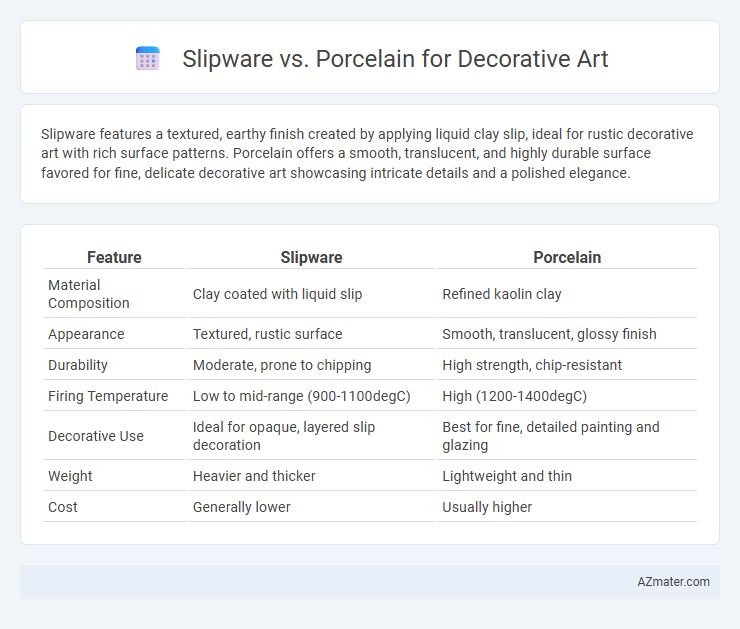Slipware features a textured, earthy finish created by applying liquid clay slip, ideal for rustic decorative art with rich surface patterns. Porcelain offers a smooth, translucent, and highly durable surface favored for fine, delicate decorative art showcasing intricate details and a polished elegance.
Table of Comparison
| Feature | Slipware | Porcelain |
|---|---|---|
| Material Composition | Clay coated with liquid slip | Refined kaolin clay |
| Appearance | Textured, rustic surface | Smooth, translucent, glossy finish |
| Durability | Moderate, prone to chipping | High strength, chip-resistant |
| Firing Temperature | Low to mid-range (900-1100degC) | High (1200-1400degC) |
| Decorative Use | Ideal for opaque, layered slip decoration | Best for fine, detailed painting and glazing |
| Weight | Heavier and thicker | Lightweight and thin |
| Cost | Generally lower | Usually higher |
Introduction to Slipware and Porcelain
Slipware is a type of pottery decorated with slip, a liquid mixture of clay and water, often showcasing vibrant motifs and textures, ideal for creating tactile, artistic designs. Porcelain, a high-fired ceramic known for its strength, translucency, and smooth surface, serves as a refined canvas for intricate decorative art and detailed painting. Both materials offer unique aesthetic qualities, with slipware emphasizing texture and color contrast, while porcelain highlights elegance and precision in decorative techniques.
Historical Background of Slipware
Slipware, originating in ancient civilizations such as Mesopotamia and Egypt, has a rich historical background marked by the use of liquid clay slip to create decorative surfaces on pottery. This technique flourished in medieval Europe and East Asia, where artisans employed slip to produce intricate patterns and vibrant color contrasts that highlighted cultural aesthetics. Unlike porcelain, which was prized for its translucence and fine texture developed in China during the Tang dynasty, slipware emphasizes tactile decoration and robust visual storytelling through painted or trailed slip designs.
Evolution of Porcelain in Decorative Art
Porcelain has evolved significantly in decorative art, transitioning from early Qing Dynasty translucent pieces to contemporary designs showcasing intricate glazing and enamel techniques. Unlike slipware, porcelain's fine-grained, high-fired clay body allows for more detailed and delicate decoration, including underglaze painting and overglaze enameling. This evolution highlights porcelain's versatility and enduring appeal in both traditional and modern decorative art forms.
Material Composition: Slipware vs Porcelain
Slipware is crafted from a clay body coated with liquid clay slip, which often includes impurities that give it a textured, rustic surface ideal for decorative glazing. Porcelain is composed of highly refined kaolin clay, fired at extremely high temperatures to produce a smooth, white, and translucent material with exceptional strength and durability. The distinct material compositions influence their aesthetic qualities and functional properties in decorative art applications.
Production Techniques and Processes
Slipware involves applying liquid clay slip to earthenware surfaces before firing, allowing for intricate patterns and textures through techniques like trailing, marbling, or sgraffito. Porcelain production requires high-temperature kiln firing of refined kaolin clay, resulting in a dense, translucent, and smooth surface ideal for detailed painting and glazing. The dual firing process in porcelain enhances durability and finish quality, while slipware emphasizes artisanal texture and visual complexity through slip application methods.
Visual and Textural Differences
Slipware features a tactile, earthy texture with distinctive brushstrokes and layered slip patterns that create a rustic, hand-crafted visual appeal. Porcelain offers a smooth, glossy surface with a refined, translucent quality, emphasizing delicate, precise details ideal for intricate decorative art. The contrast lies in slipware's organic, matte finish versus porcelain's sleek, polished elegance, influencing the overall aesthetic and sensory experience.
Durability and Functional Aspects
Slipware, known for its rustic charm, offers excellent durability due to its thick, robust clay body, making it suitable for everyday functional use and decorative purposes. Porcelain, with its fine, vitrified structure, provides superior strength, resistance to chipping, and a smooth, translucent finish ideal for delicate decorative art. Both materials balance durability and aesthetic appeal, but porcelain excels in functional applications requiring precision and durability, while slipware favors a handmade, tactile quality for artistic expression.
Artistic Styles and Common Motifs
Slipware and porcelain differ significantly in artistic styles and common motifs, reflecting their distinct cultural histories. Slipware often features rustic, folk-inspired designs with vibrant, earthy colors and motifs such as floral patterns, animals, and traditional symbols created using slip trailing and sgraffito techniques. Porcelain, known for its smooth, translucent surface, typically showcases refined, delicate art styles like intricate blue-and-white patterns, chinoiserie, and naturalistic depictions, emphasizing elegance and precision.
Modern Trends and Collectibility
Slipware's earthy textures and organic glazes appeal to collectors seeking handmade, artisanal qualities reflecting modern trends in sustainable and rustic decor. Porcelain, valued for its translucency, fine craftsmanship, and durability, remains a top choice in contemporary decorative art, especially in minimalist and luxury markets. Both materials exhibit strong collectibility, with slipware favored for unique, one-of-a-kind pieces and porcelain prized for its refined aesthetic and historical prestige.
Choosing Between Slipware and Porcelain for Decorative Purposes
Slipware offers rich textures and earthy tones ideal for rustic or traditional decorative art, emphasizing handcrafted aesthetics and tactile appeal. Porcelain provides a smooth, fine surface with a translucent quality that suits intricate designs and contemporary elegance, favored for its durability and refined finish. Choosing between slipware and porcelain depends on the desired visual impact, tactile experience, and thematic style of the decorative piece.

Infographic: Slipware vs Porcelain for Decorative Art
 azmater.com
azmater.com